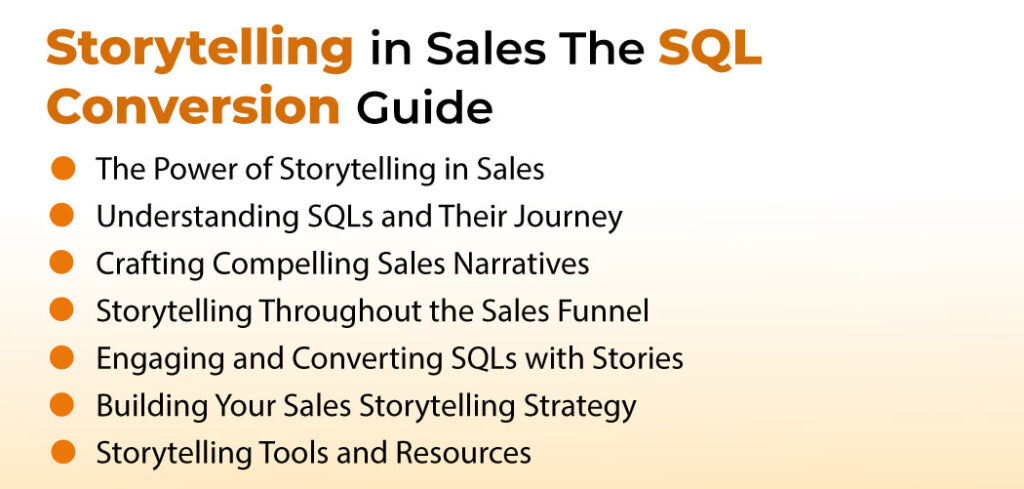
In the fast-paced world of sales, where technology meets human connection, storytelling has emerged as a potent tool. Crafting compelling narratives can transform mere leads into Sales Qualified Leads (SQLs), leading to meaningful customer relationships and, ultimately, conversions. This blog unravels the intricate relationship between storytelling and SQL conversion, unveiling techniques, strategies, and the pervasive influence of storytelling throughout the sales journey.
Must Read: MQL to SQL Conversion Rate
Storytelling in Sales: The SQL Conversion Guide
Table of Contents
- 1 Storytelling in Sales: The SQL Conversion Guide
- 1.1 The Power of Storytelling in Sales
- 1.2 Understanding SQLs and Their Journey
- 1.3 Crafting Compelling Sales Narratives
- 1.4 Storytelling Throughout the Sales Funnel
- 1.5 Engaging and Converting SQLs with Stories
- 1.6 Building Your Sales Storytelling Strategy
- 1.7 Storytelling Tools and Resources
- 1.8 Conclusion
- 1.9 Share this:

The Power of Storytelling in Sales
At its core, storytelling is about invoking emotions and forging connections. A recent survey found that a staggering 92% of consumers prefer ads that feel like a story. In the realm of sales, narratives infuse authenticity and relatability, nurturing trust and engagement. A well-told story can enrapture an audience, making products or services more tangible and appealing.
Must Read: From SQL to Loyal Customer: The Journey of Nurturing Leads
Understanding SQLs and Their Journey
Before delving into the art of storytelling, comprehending SQLs and their odyssey within the sales funnel is paramount. SQLs are prospective customers exhibiting a robust interest in a product or service, manifesting an intent to make a purchase. Their voyage is marked by research, evaluations, and comparisons. To create narratives that deeply resonate, understanding their pain points and aspirations is fundamental.
Crafting Compelling Sales Narratives
Creating compelling sales narratives mandates an intricate understanding of the audience and their exigencies. It extends beyond spotlighting features; it entails weaving a story around how a product or service genuinely addresses a real problem. Data indicates that 64% of consumers believe that shared values engender trust in a brand. The integration of these values into the narrative fosters an emotional connection, significantly boosting the likelihood of conversion.
Must Read: Unconventional Ways to Generate Qualified B2B Sales Leads
Storytelling Throughout the Sales Funnel
Storytelling isn’t limited to a single stage within the sales funnel; it’s a dynamic force that should seamlessly thread from awareness to post-purchase engagement. Engaging narratives during the awareness phase generate interest. Personalized stories during the consideration phase provide the needed nudge toward conversion. Even post-purchase, continuous storytelling cultivates brand loyalty and prompts referrals.
Engaging and Converting SQLs with Stories
Mastering the art of engaging and converting SQLs is achieved through strategic storytelling. By aligning narratives with prospects’ pain points and aspirations, sales teams can craft a compelling case for a product or service. Studies have revealed that brands incorporating storytelling techniques experienced a substantial 30% increase in customer engagement. The inclusion of success stories and testimonials lends credibility to the narrative, reinforcing trust and enhancing the likelihood of conversion.
Must Read: Sales Cadence Best Practices: Why You Should Always Dial First
Building Your Sales Storytelling Strategy
Developing an effective sales storytelling strategy necessitates meticulous planning and a dash of creativity. Valuable insights can be gleaned by analyzing data on customer preferences, pain points, and behaviors. Leveraging tools like CRM software and analytics platforms enable the personalization of narratives. A well-structured strategy ensures consistent messaging across all touchpoints, strengthening the brand story.
Storytelling Tools and Resources
In the digital era, a plethora of tools and resources empower sales teams to craft captivating narratives. Interactive presentations, multimedia content, and virtual reality experiences immerse prospects in the brand’s story. Social media platforms serve as ideal avenues for sharing micro-stories, generating buzz around the brand. Statistics show that content enriched with relevant images garners an astounding 94% more views. Notably, visual storytelling resonates profoundly with contemporary consumers.
Must Read: What Is MQL & SQL and How Do They Differ?
Conclusion
In the fiercely competitive sales landscape, storytelling emerges as the clandestine weapon that transcends mere data points and metrics. It humanizes brands, making them relatable and trustworthy. Through well-crafted narratives, SQL conversion evolves from a transactional process into a journey marked by authentic connections and shared values. As sales professionals embrace the art of storytelling, they pave the way for enduring customer relationships, amplified conversion rates, and a brand story that reverberates in the hearts and minds of consumers. In the realm of sales, a compelling story isn’t merely a narrative; it is the key to unlocking doors of possibilities and potential.

Vikas Bhatt is the Co-Founder of ONLY B2B, a premium B2B lead generation company that specializes in helping businesses achieve their growth objectives through targeted marketing & sales campaigns. With 10+ years of experience in the industry, Vikas has a deep understanding of the challenges faced by businesses today and has developed a unique approach to lead generation that has helped clients across a range of industries around the globe. As a thought leader in the B2B marketing community, ONLY B2B specializes in demand generation, content syndication, database services and more.

.webp)
